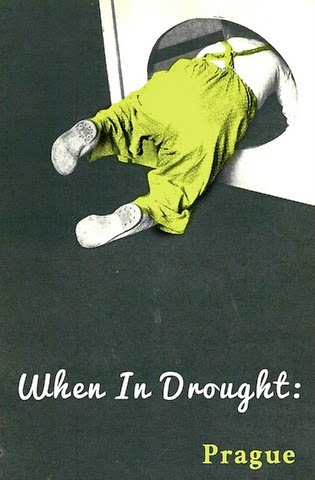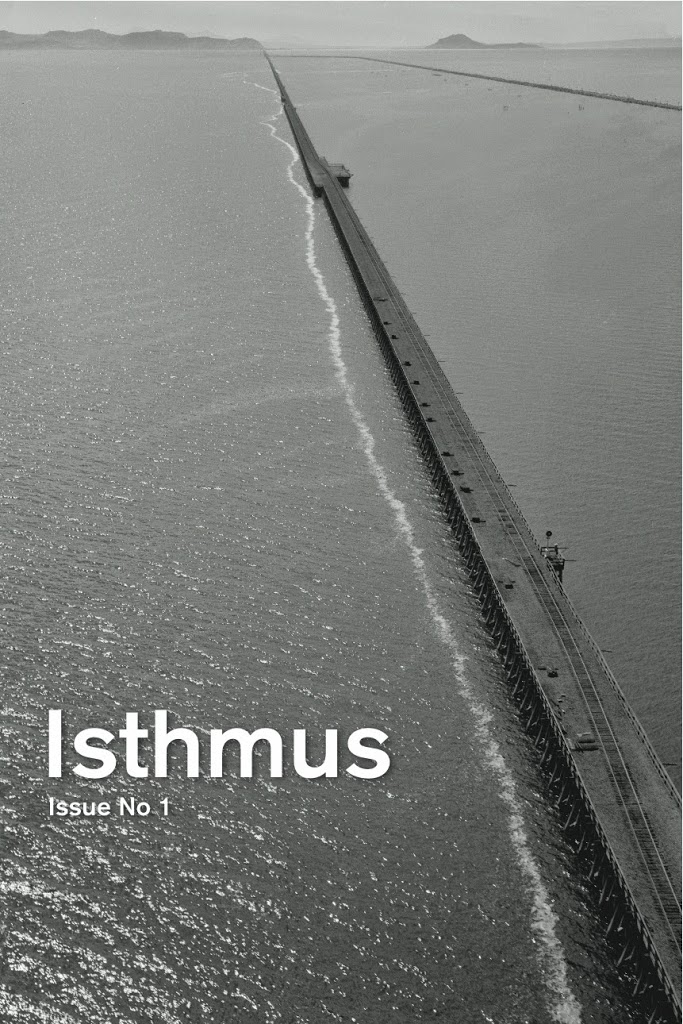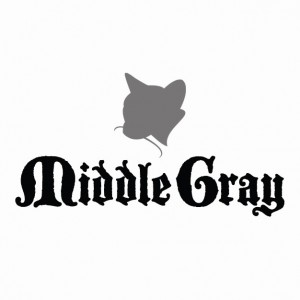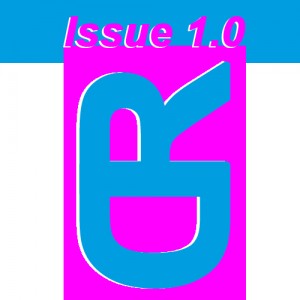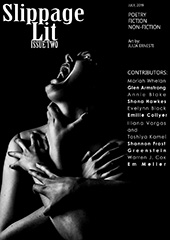 I have a friend who likes to order items on a menu that are sound fun to say when we go out to eat. That’s how I first came to try calamari and bibimbap. It’s also a way to discover great new lit mags, like Slippage Lit, whose co-editors, Jacob Parsons and Admir Šiljak, along with Social Media Editor Semina Pekmezović, admit they chose the name because they just like the way it sounds. But that’s not the only reason. Continue reading “New Lit on the Block :: Slippage Lit”
I have a friend who likes to order items on a menu that are sound fun to say when we go out to eat. That’s how I first came to try calamari and bibimbap. It’s also a way to discover great new lit mags, like Slippage Lit, whose co-editors, Jacob Parsons and Admir Šiljak, along with Social Media Editor Semina Pekmezović, admit they chose the name because they just like the way it sounds. But that’s not the only reason. Continue reading “New Lit on the Block :: Slippage Lit”
New Lit on the Block: Paperbark
Promising “stimulating, relevant, high-quality writing and art from across the world” focused on issues related to climate change, environmental justice, social justice, and, in the case of their upcoming second issue, resilience, Paperbark Literary Magazine is a stunning new annual of poetry, prose, and visual and multimedia art. Continue reading “New Lit on the Block: Paperbark”
New Lit on the Block: The Shore
 Cutting, strange, and daring are the words The Shore uses to describe the kind of poetry they seek to publish for its readership. Like the waters of lakes or seas or even rivers, the editors detail, “We want poems that push and ache and recede.” And like any beautiful and powerful shoreline, how could readers and writers not be drawn in? Continue reading “New Lit on the Block: The Shore”
Cutting, strange, and daring are the words The Shore uses to describe the kind of poetry they seek to publish for its readership. Like the waters of lakes or seas or even rivers, the editors detail, “We want poems that push and ache and recede.” And like any beautiful and powerful shoreline, how could readers and writers not be drawn in? Continue reading “New Lit on the Block: The Shore”
New Lit on the Block :: The 4×2 Project
What do you do if you’re a lit mag that has been successfully publishing poets at all stages of their careers for two decades? Well, you start a NEW publication, of course, with an entirely NEW mission! The 4×2 Project is exactly that. Continue reading “New Lit on the Block :: The 4×2 Project”
New Lit on the Block :: Okay Donkey
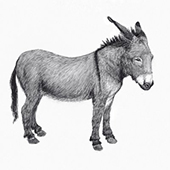 If the idea of snuggling up to a stack of submissions sounds like the most romantic way to spend your evening with the one you love, then you can pretty much imagine the lives of Genevieve Kersten and Eric Andrew Newman, editors of the newest online venue for poetry and flash fiction: Okay Donkey. Continue reading “New Lit on the Block :: Okay Donkey”
If the idea of snuggling up to a stack of submissions sounds like the most romantic way to spend your evening with the one you love, then you can pretty much imagine the lives of Genevieve Kersten and Eric Andrew Newman, editors of the newest online venue for poetry and flash fiction: Okay Donkey. Continue reading “New Lit on the Block :: Okay Donkey”
New Lit on the Block :: Thriller Magazine
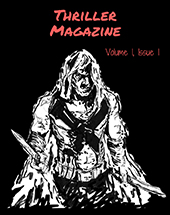 With a name like Thriller Magazine, there’s little room for mistaking the genre of this new online biannual publishing short stories and flash fiction under the umbrella of thriller/suspense/mystery. And with Editor in Chief Ammar Habib’s background, readers of this publication can expect to experience quality genre literature, while writers can expect that their work will be respectfully considered. Continue reading “New Lit on the Block :: Thriller Magazine”
With a name like Thriller Magazine, there’s little room for mistaking the genre of this new online biannual publishing short stories and flash fiction under the umbrella of thriller/suspense/mystery. And with Editor in Chief Ammar Habib’s background, readers of this publication can expect to experience quality genre literature, while writers can expect that their work will be respectfully considered. Continue reading “New Lit on the Block :: Thriller Magazine”
New Lit on the Block :: Months To Years
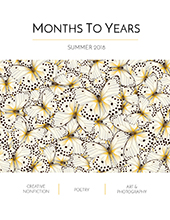 Death. Dying. Terminal illness. Words – and experiences – we tend to avoid, not want to talk about and, most certainly, not want to experience. Yet, as Founding Editor Renata Khoshroo Louwers says, these are topics that touch everyone’s life at some point. Which is why she and her husband began Months To Years, the online quarterly of creative nonfiction, poetry, photography, and art, as a response to their own experiences with loss as well as a way to support others. Continue reading “New Lit on the Block :: Months To Years”
Death. Dying. Terminal illness. Words – and experiences – we tend to avoid, not want to talk about and, most certainly, not want to experience. Yet, as Founding Editor Renata Khoshroo Louwers says, these are topics that touch everyone’s life at some point. Which is why she and her husband began Months To Years, the online quarterly of creative nonfiction, poetry, photography, and art, as a response to their own experiences with loss as well as a way to support others. Continue reading “New Lit on the Block :: Months To Years”
New Lit on the Block :: Crossways Literary Magazine
The titles of WB Yeats’s first collection of poems is the inspiration behind the naming of Crossways Literary Magazine, an online quarterly of poetry and short fiction based out of Ireland.
But the core inspiration behind this new publication was Founding Editor David Jordan’s “limited success” in getting his own work published. “I decided I would go to the other side and be the publisher and the person who says yes. I figured I might have more success in this role and get satisfaction from it.” Continue reading “New Lit on the Block :: Crossways Literary Magazine”
New Lit on the Block :: The Esthetic Apostle
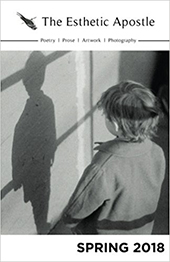 Based out of Chicago, The Esthetic Apostle is a new online monthly of poetry, prose, artwork and photography which also releases print issues quarterly.
Based out of Chicago, The Esthetic Apostle is a new online monthly of poetry, prose, artwork and photography which also releases print issues quarterly.
“Promoting creative individuals, self-realization/development, and beautiful ideas” are what motivated this start-up, as Founder and Editor-in-Chief Samuel M. Griffin explains. “The wit and wisdom of Oscar Wilde was a primary catalyst. As a tribute to our city and Wilde, we named the magazine The Esthetic Apostle after a Chicago Tribune headline describing Wilde’s visit to the windy city.” And if you’re wondering about the spelling…
Continue reading “New Lit on the Block :: The Esthetic Apostle”
New Lit on the Block :: SWWIM Every Day
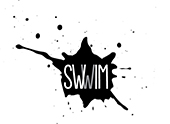 What better way to usher in summer than to introduce SWWIM Every Day? SWWIM actually stands for Supporting Women Writers in Miami, and although it retains its origin’s namesake, everyone is invited to enjoy the international reach of contributors included in this daily online publication of poetry by women, women-identifying and femme-presenting writers. Continue reading “New Lit on the Block :: SWWIM Every Day”
What better way to usher in summer than to introduce SWWIM Every Day? SWWIM actually stands for Supporting Women Writers in Miami, and although it retains its origin’s namesake, everyone is invited to enjoy the international reach of contributors included in this daily online publication of poetry by women, women-identifying and femme-presenting writers. Continue reading “New Lit on the Block :: SWWIM Every Day”
New Lit on the Block :: Angry Old Man
“Anger is an energy, according to Johnny Lydon. Who am I to argue?” comments Drew B. David, sole editor and “energy” behind Angry Old Man, a new print and online quarterly publishing all textual and visual forms, with mixed media (or intermedia) especially encouraged. Angry Old Man is a lit mag dedicated to textual-visual hybridization and true aesthetic experimentation. Continue reading “New Lit on the Block :: Angry Old Man”
New Lit on the Block :: Iron City Magazine
 If this data shared by Iron City Magazine doesn’t startle or sadden you, then you need to get woke: “The U.S., with less than 5% of the world’s population, has more than 20% of its prisoners, more people by raw number than any other nation in the world, regardless of size. Given that 1 in 135 Americans lives behind bars, U.S. prison complexes are like vast cities. If they were made into a state, it would be the 36th most populated.”
If this data shared by Iron City Magazine doesn’t startle or sadden you, then you need to get woke: “The U.S., with less than 5% of the world’s population, has more than 20% of its prisoners, more people by raw number than any other nation in the world, regardless of size. Given that 1 in 135 Americans lives behind bars, U.S. prison complexes are like vast cities. If they were made into a state, it would be the 36th most populated.”
Iron City Magazine: Creative Expressions By and For the Incarcerated is an annual online and print journal devoted entirely to writing and art from the prison world, and one that we should all be reading. The name, Iron City Magazine ’s Marketing Editor Jacqueline Aguilar tells me, comes from the image the word “prison” conjures in most of us: “Even though most prisons are chiefly nowadays made of concrete more than iron, it’s still the iron doors, iron bars, and razor wire that most resonate with our image of prison life.” Continue reading “New Lit on the Block :: Iron City Magazine”
New Lit on the Block :: The HitchLit Review
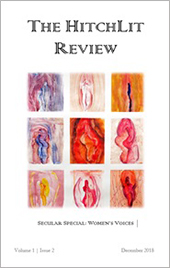 The HitchLit Review: A Secular Literary-Arts Journal publishes online twice per year, poetry, fiction, and non-fiction, and would consider short, stand-alone scenes from plays and screen plays as well as visual art and cover design. “There are many literary magazines,” The HitchLit Review Founder and Editor Daniel Ruefman tells me, “but in a growing community of secular voices, few publications are focused on giveing them a platform. In addition to that, there are a lot of misunderstandings about what it means to be secular today (atheist, agnostic, freethinker, skeptic, etc.). By highlighting secular voices through literature and art, HitchLit hopes to confront stereotypes and demonstrate just how diverse the secular community is.”
The HitchLit Review: A Secular Literary-Arts Journal publishes online twice per year, poetry, fiction, and non-fiction, and would consider short, stand-alone scenes from plays and screen plays as well as visual art and cover design. “There are many literary magazines,” The HitchLit Review Founder and Editor Daniel Ruefman tells me, “but in a growing community of secular voices, few publications are focused on giveing them a platform. In addition to that, there are a lot of misunderstandings about what it means to be secular today (atheist, agnostic, freethinker, skeptic, etc.). By highlighting secular voices through literature and art, HitchLit hopes to confront stereotypes and demonstrate just how diverse the secular community is.”
Continue reading “New Lit on the Block :: The HitchLit Review”
New Lit on the Block :: Twyckenham Notes
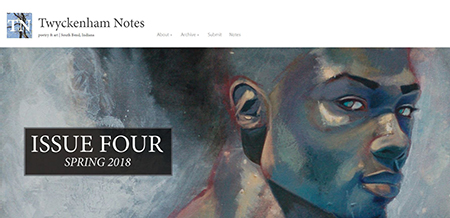 Twyckenham is a name linked strongly with South Bend and Twyckenham Notes Editor in Chief Austin Veldman, who grew up there at a time when the economic slump felt by many post-automobile industry cities lingered on. “In the early 2000’s,” Veldman says, “the prevalent attitude of the town’s youth was not lost on me: I wanted to leave as soon as I could. The common words among most were there is nothing to do here.” And yet, not even a decade later, Veldman founded Twyckenham Notes in response to what he saw happening in his city, “a reemergence, the founding of a new identity,” contributing literature to help in this rebirth and renewal.
Twyckenham is a name linked strongly with South Bend and Twyckenham Notes Editor in Chief Austin Veldman, who grew up there at a time when the economic slump felt by many post-automobile industry cities lingered on. “In the early 2000’s,” Veldman says, “the prevalent attitude of the town’s youth was not lost on me: I wanted to leave as soon as I could. The common words among most were there is nothing to do here.” And yet, not even a decade later, Veldman founded Twyckenham Notes in response to what he saw happening in his city, “a reemergence, the founding of a new identity,” contributing literature to help in this rebirth and renewal.
New Lit on the Block :: MORIA Literary Magazine
 Olives are a succulent fruit, each containing a seed with which to grow more nourishing deliciousness. What better inspiration, then, for MORIA, the new literary publication from Woodbury University, where an olive grove once stood on the land that now houses this Californian educational institution.
Olives are a succulent fruit, each containing a seed with which to grow more nourishing deliciousness. What better inspiration, then, for MORIA, the new literary publication from Woodbury University, where an olive grove once stood on the land that now houses this Californian educational institution.
Faculty Editor of MORIA Literary Magazine, Dr. Linda L. Dove, tells me MORIA refers to a special type of olive tree in ancient Greece that is protected by the government. “As a tree sacred to Athena, the goddess of wisdom, the original ‘Moria’ was believed to have been planted by her at the Parthenon and includes the meaning ‘to be part of’ something larger than itself. Here at the literary magazine, we recognize and celebrate that Woodbury University is a part of a tradition of learning that is larger than itself, just as literature and the writers who make it are part of a tradition of creative engagement and cultural production that is larger than any one individual alone.” Beautiful.
Continue reading “New Lit on the Block :: MORIA Literary Magazine”
New Lit on the Block :: The Indianapolis Review
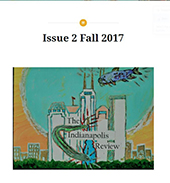 The Indianapolis Review is a new online quarterly of poetry and visual art supporting the growth of new voices in the literary scene in Indianapolis and beyond. Founder and Editor in Chief Natalie Solmer and Associate Editor Rachel Sahaidachny started the publication “to give back to the poetry and art world by curating a platform to showcase poets and artists. We desire to create connections among writers and artists in our community and around the globe. In our own publishing experiences, we’ve seen there is always a need for venues to publish new work.”
The Indianapolis Review is a new online quarterly of poetry and visual art supporting the growth of new voices in the literary scene in Indianapolis and beyond. Founder and Editor in Chief Natalie Solmer and Associate Editor Rachel Sahaidachny started the publication “to give back to the poetry and art world by curating a platform to showcase poets and artists. We desire to create connections among writers and artists in our community and around the globe. In our own publishing experiences, we’ve seen there is always a need for venues to publish new work.”
Continue reading “New Lit on the Block :: The Indianapolis Review”
New Lit on the Block :: Virga
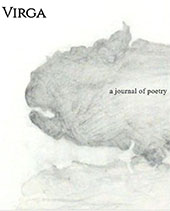 Virga is the name for the cloud streaks that stream hazily down from the sky, snow or rain precipitation that evaporates before having a chance to reach the ground. Virga can often fool radar into recording precipitation while the ground remains dry. Perhaps in this same way, poetic and hybrid forms can be as elusive as nature herself, and why Virga is an appropriate name for new online literary biannual dedicated to poetry and hybrid writing. Continue reading “New Lit on the Block :: Virga”
Virga is the name for the cloud streaks that stream hazily down from the sky, snow or rain precipitation that evaporates before having a chance to reach the ground. Virga can often fool radar into recording precipitation while the ground remains dry. Perhaps in this same way, poetic and hybrid forms can be as elusive as nature herself, and why Virga is an appropriate name for new online literary biannual dedicated to poetry and hybrid writing. Continue reading “New Lit on the Block :: Virga”
New Lit on the Block :: Embark
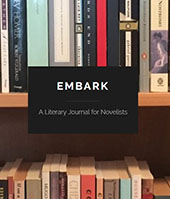 Teaching a course in The Novel, I took my students to the fiction section of the library and had them pull down books at random and simply read the first several pages, sometimes just the first sentence. I wanted them to sample as many “beginnings” as they could, then comment on the exercise. Some said they liked it as a way to consider a lot of books and see which one might grab their interest; overwhelmingly, they all wanted to go back and keep reading at least one or more of what they had sampled. Now, imagine this experience of sampling first chapters at your fingertips, on the computer, in one publication, and you will have imagined Embark. Continue reading “New Lit on the Block :: Embark”
Teaching a course in The Novel, I took my students to the fiction section of the library and had them pull down books at random and simply read the first several pages, sometimes just the first sentence. I wanted them to sample as many “beginnings” as they could, then comment on the exercise. Some said they liked it as a way to consider a lot of books and see which one might grab their interest; overwhelmingly, they all wanted to go back and keep reading at least one or more of what they had sampled. Now, imagine this experience of sampling first chapters at your fingertips, on the computer, in one publication, and you will have imagined Embark. Continue reading “New Lit on the Block :: Embark”
New Lit on the Block :: Sky Island Journal
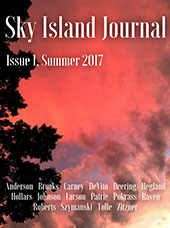 Born in the southern reaches of Arizona and New Mexico, Sky Island Journal is a new, open access online quarterly of poetry, flash fiction, and brief creative nonfiction. Just like its unique geographical namesake, Sky Island Journal promises, “as a writer, no matter who you are, where you’re from, or what you write about – if you’ve ever felt a connection to landscapes, art, or people, your writing might very well find a home with us. As a reader, you’re in for a real treat.” Continue reading “New Lit on the Block :: Sky Island Journal”
Born in the southern reaches of Arizona and New Mexico, Sky Island Journal is a new, open access online quarterly of poetry, flash fiction, and brief creative nonfiction. Just like its unique geographical namesake, Sky Island Journal promises, “as a writer, no matter who you are, where you’re from, or what you write about – if you’ve ever felt a connection to landscapes, art, or people, your writing might very well find a home with us. As a reader, you’re in for a real treat.” Continue reading “New Lit on the Block :: Sky Island Journal”
New Lit on the Block :: Arkana
Arkana is a new biannual online journal published by the Arkansas Writers MFA Program at the University of Central Arkansas. While the name may seem obviously connected to the place, “arcana” can also mean a secret or a mystery, or a powerful and secret remedy, some “great secret of nature that the alchemists sought to discover.” This definition, the editors explain, is what they want Arkana to be all about: “discovering powerful voices that haven’t previously been heard, but speak to human nature and the human experience. Publishing every genre possible, and with the welcoming flexibility online offers, the editors want to “be the literary journal of mysteries and marginalized voices—to champion the arcane.” Continue reading “New Lit on the Block :: Arkana”
New Lit on the Block :: Cold Creek Review
Ever stuck your foot or hand into ice cold water and held it there, feeling the numbness of the aftershock? How about the whacky idea of a polar plunge – your whole body into an icy lake – can you imagine what that must feel like? Believe it or not, that’s the exact sensation the editors of Cold Creek Review were going for when they named their online publication. “We wanted to focus on literature and art that makes you feel paralyzed,” Editor-in-Chief for Poetry and Nonfiction Amber D. Tran tells me. “We imagine reading and reviewing our featured pieces leaves you with a sense of frozen time, like you were being submerged in a body of ice-cold water.” Continue reading “New Lit on the Block :: Cold Creek Review”
New Lit on the Block :: Reverberations
Art is at the center of Reverberations, a digital publication of writing that “investigates the way that art echoes beyond itself and interacts with ourselves,” says Editor Linne Halpren. Editor Sage Marshall adds, “Art is often created in response to something else, and our thoughts on art are further reverberations.” Continue reading “New Lit on the Block :: Reverberations”
New Lit on the Block :: Curieux Academic Journal
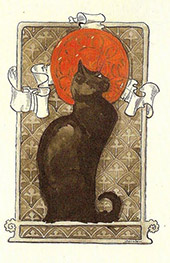 When he sought to name his newly envisioned academic journal for high school writers, Theodore Bass said the word ‘curious’ embodied what he wanted to do with the publication. In French, the word is ‘curieux,’ which Bass thought had a nicer ring to it. Thus, Curieux Academic Journal was christened. Continue reading “New Lit on the Block :: Curieux Academic Journal”
When he sought to name his newly envisioned academic journal for high school writers, Theodore Bass said the word ‘curious’ embodied what he wanted to do with the publication. In French, the word is ‘curieux,’ which Bass thought had a nicer ring to it. Thus, Curieux Academic Journal was christened. Continue reading “New Lit on the Block :: Curieux Academic Journal”
New Lit on the Block :: The Drowning Gull
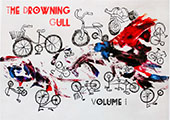 The Drowning Gull online biannual of art, nonfiction, poetry and fiction hails an eclectic editorial staff: Tiegan Dakin, a poet and artist living in New South Wales, Australia; Rebecca Valley, poet and writer living in Washington state; Shonavee Simpson, Australian freelancer from Newcastle; and Katelyn Dunne, a Chicago native currently living in Kentucky to attend university. “Living in different parts of the world,” says Dakin, “makes communication difficult at times. But we all have a common love of publishing, so we try tirelessly to make it work.” Continue reading “New Lit on the Block :: The Drowning Gull”
The Drowning Gull online biannual of art, nonfiction, poetry and fiction hails an eclectic editorial staff: Tiegan Dakin, a poet and artist living in New South Wales, Australia; Rebecca Valley, poet and writer living in Washington state; Shonavee Simpson, Australian freelancer from Newcastle; and Katelyn Dunne, a Chicago native currently living in Kentucky to attend university. “Living in different parts of the world,” says Dakin, “makes communication difficult at times. But we all have a common love of publishing, so we try tirelessly to make it work.” Continue reading “New Lit on the Block :: The Drowning Gull”
New Lit on the Block :: Under a Warm Green Linden
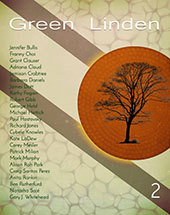 Buy a broadside; plant a tree.
Buy a broadside; plant a tree.
I can’t imagine a more unique approach to both printing poetry to share with the world and planting trees to renew the planet. It is the creative genius of Under a Warm Green Linden, an online journal of poetry and poetics which publishes poetry (including audio recordings of poets reading their work), interviews with poets, reviews of poetry books, and poetry broadsides. Reviews and interviews are published throughout the year while the poetry journal featuring 24-30 poets is published twice a year, on summer and winter solstices.
Continue reading “New Lit on the Block :: Under a Warm Green Linden”
New Lit on the Block :: Sink Hollow
Sink Hollow is a landmark of Logan Canyon, at the mouth of which stands Utah State University and its iconic Old Main Building bell tower. In the canyon, Sink Hollow refers to a series of depressions that trap cold air, causing the hollows to be noticeably colder than the rest of the canyon. Visitors can expect to find frost on a July afternoon in the sinks.
New Lit on the Block :: Heather
 “Heather is your friend. Heather is your girlfriend. Heather is your girlfriend’s girlfriend. Heather is leaning against the wall at your neighbor’s house party. Heather is next to you in bed, naked.”
“Heather is your friend. Heather is your girlfriend. Heather is your girlfriend’s girlfriend. Heather is leaning against the wall at your neighbor’s house party. Heather is next to you in bed, naked.”
Enticed? I certainly was, which is why I contacted Kelsey Mars, founder and sole editor of Heather, a new online indie literary publication, to learn more about this nakedness next to me in bed.
First – the name. “Heather,” Kelsey tells me, “is a unique feminine name, as well as being a shade of purple and a color generally associated with alternative sexuality. I wanted Heather as a publication to embody all aspects of this, to draw up images of bad girls in pleated skirts and the back row of the movie theater.”
Publishing fiction, non-fiction and poetry as well as digital art, photography and film, readers can determine whether or not the content stands up to its namesake. The free, online PDF features poems “about subjects that might make you uncomfortable,” Kelsey warns, as well as “erotica, film to chew on, stories about robots, flash fiction to make you cry a single diamond tear.”
While new to this venture, Kelsey is a seasoned literary professional. “I’ve been published in Huffington Post: Queer Voices, Thought Catalog, Miscellany, Meat For Tea and am upcoming in Painted Bride. You can read my original screenplay, Gotham Summer, as I tweet it out: @gothamsummer. I studied Media Theory and Communications at the College of Charleston, where I was first introduced to flash fiction writing. Since then, I’ve written two novels and more poems and flash fiction than is healthy for one person. In the light of day, I work on the Customer Experience team at Casper Sleep and preach the good word of Elizabeth Gilbert’s Big Magic: Never ask your art to pay for you.”
While involved in so much of her own writing,I asked Kelsey the motivation for adding this responsibility. “So many of us get rejection after rejection, often without knowing why. So many voices go unheard in this industry and it’s a damn shame. I started Heather to publish the weird stuff, the stuff that other publications might not see as ‘premium’ or literary enough. I wanted experimental stuff, the weirdest thing someone has ever written. I wanted a home for that stuff.”
Writers looking to home their works should know that Kelsey manages submissions on a rolling basis, accepting works as they fit the arc of each issue, offering the work more than one shot, but releasing it if it hasn’t found its fit after two issue cycles. Heather accepts simultaneous submissions, which keeps the editorial process timely.
Already, Heather has been made home by authors such as Maggie Cooper, whose first published pieces of fiction appeared in Heather and, as Kelsey notes: “totally blew my mind”; Monique Quintana, a fiction editor herself “whose shit haunts my dreams” Kelsey says; and Kirsten Bledsoe, a filmmaker whom Kelsesy knew prior to Heather, who has made both a feature length series about queer women of color and a prodigious ode to Marilyn Monroe’s poetry (which Heather published).
The future for Heather is boundless: “I want to go to Mars, dude,” Kelsey tells me with an edge of seriousness. “I want to see what’s outside of our solar system. Send me poems, fiction, art about that stuff. The stuff that we don’t even know yet. Let’s go to uncharted territory and live to brag about it.” Back down on earth, Kelsey hopes to publish Heather three times this year and keep the publication going well beyond that.
In addition to the regular publishing cycle, Kelsey is planning a special holday issue. The publication is not holiday themed, “but rather what you actually want to be reading when you’re avoiding your family over the holidays,” Kelsey says. “I’d like to publish more creative nonfiction in this issue, poetry about our fears, things like that.” Submissions accepted via Submittable; deadline November 27 to be published December 11.
As a final word, Kelsey encourages writers: “The most important thing I want people to take away from Heather is that you can do it to. You can publish the stuff YOU love. And if more of us do that, more of us will realize we’re someone’s favorite thing.”
New Lit on the Block :: Cherry Tree
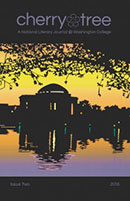 Cherry Tree: A National Literary Journal is a new print annual of poetry, fiction, and creative nonfiction from Literary House Press at Washington College. While Washington College is a small liberal arts college that takes great pride in its undergraduate creative writing program, Founder and Editor Jehanne Dubrow realized the one thing it lacked (in comparison to peer institutions) was a national literary journal, a publication that provided the opportunity for undergrad students to participate actively in the wider literary world and the current conversations happening there. “Cherry Tree was a long time coming for us and we’re so glad to be here at last!”
Cherry Tree: A National Literary Journal is a new print annual of poetry, fiction, and creative nonfiction from Literary House Press at Washington College. While Washington College is a small liberal arts college that takes great pride in its undergraduate creative writing program, Founder and Editor Jehanne Dubrow realized the one thing it lacked (in comparison to peer institutions) was a national literary journal, a publication that provided the opportunity for undergrad students to participate actively in the wider literary world and the current conversations happening there. “Cherry Tree was a long time coming for us and we’re so glad to be here at last!”
As may seem obvious, the name Cherry Tree honors George Washington, but perhaps less well known, the editors share, is the fact that, “in 1782, Washington gifted ‘the College at Chester’ 50 guineas, consented to serve on its Board, and gave the educational institution permission to use his name. In the American imagination, George Washington is a figure who has come to represent both truth-telling and mythmaking. The famous story of the cherry tree—I can’t tell a lie, Pa; you know I can’t tell a lie. I did cut it with my hatchet.—reminds us that there is truth even in invention, that even apocrypha can convey the facts of life.”
Truth be told, Cherry Tree is extremely well-staffed for a start-up publication. Jehanne Dubrow is the author of five poetry collections, including most recently The Arranged Marriage (UNMP 2015). Her scholarly and teaching interests include creative writing, formal poetry, prosody, American Jewish literature, Holocaust studies, and the graphic novel. Managing Editor Lindsay Lusby, winner of the 2015 Fairy Tale Review Award in Poetry, is Assistant Director of the Rose O’Neill Literary House and Assistant Editor of the Literary House Press. Poetry & Creative Nonfiction Editor James is Associate Professor of English at Washington College, and Fiction Editor Kate Kostelnik earned her Ph.D in English from the University of Nebraska and her MFA from the University of Montana and now teaches at the University of Virginia in Charlottesville.
Cherry Tree also involves a staff of student screeners serving the first round of reading for all submissions during the open reading period. Selected works are moved up to Senior Readers, and then Fiction Editor, and Poetry & Creative Nonfiction Editor. Dubrow makes the final determination about which pieces will be published. Student screeners are all undergraduate students at Washington College (or very recent graduates) who have successfully completed the English Department’s Literary Editing & Publishing class.
Writers interested in submitting to the publication will appreciate the publication’s mission. According to the editors, “We are writers who value and publish well-crafted short stories, poems, and creative nonfiction essays that are not afraid to make us care. We want work that braves to be, that dares to be. We encourage well-informed work where the form understands its relationship with the content. We want pieces that seem wise, that are unafraid to confront topics that matter, and that speak with urgency, that beg for an ear to listen. We want to read vividly-drawn characters who challenge and enlarge our sympathy.”
Readers coming to Cherry Tree will find what the editors believe to be the best poems, short stories, and essays holding “the truth and lyricism of language above sentimentality and message-making” from both established and emerging writers. While readers may choose to “cherry-pick” pieces, the editors advocate reading a full issue from cover to cover, “because we always order the pieces in such a way as to create a sort of thematic story arc, making the reading experience more engrossing and meaningful.”
Previously published contributors include Rick Barot, Jericho Brown, Jennifer S. Cheng, Claudia Emerson, Vievee Francis, Anna Journey, Julie Kane, Roy Kesey, Matthew Lippman, Paul Lisicky, Matthew Olzmann, Emilia Phillips, sam sax, Bruce Snider, and Julie Marie Wade.
Cherry Tree opens for general submissions in the categories of poetry, fiction, and creative nonfiction from August 15 to October 15 each year via Submittable only.
New Lit on the Block :: The 3288 Review
 Michigan-based The 3288 Review is a new print and ebook quarterly publishing short fiction, nonfiction (essays and creative non-fiction), poetry of all forms and formats, reviews, photography, and artwork, with an ongoing interview series on their website.
Michigan-based The 3288 Review is a new print and ebook quarterly publishing short fiction, nonfiction (essays and creative non-fiction), poetry of all forms and formats, reviews, photography, and artwork, with an ongoing interview series on their website.
What’s with 3288? Purely a Michigan thing, as Editor-in-Chief John Winkelman tells me: “We wanted a name which reflected something about Michigan. Based on a survey done in 2000, Michigan has a total of 3,288 miles of coastline (including islands). However, with the rise in water levels over recent years, we may need to revisit this.”
A project of Caffeinated Press, established in 2014 as an independent publisher serving the authors and readers of the West Michigan community, The 3288 Review is dedicated to finding and showcasing literary and artistic talent with a particular focus on West Michigan. Winkelman explains the publication’s philosophy, “Literary journals provide a good point of entry for new writers, and can be more narrowly focused than can publishing companies as a whole. We feel that West Michigan talent is under-represented in the larger literary world, and we want to do something about that.”
Working alongside the editor-in-chief are Jason Gillikin (fiction editor), Elyse Wild (nonfiction editor), and Leigh Jajuga (poetry editor) who read all submissions blind, providing input and feedback. Accepted submissions are then “curated” for individual issues.
The 3288 Review readers can expect to find finely crafted arts and letters, with that particular focus on talent from West Michigan. Some recent contributors include Lisa Gundry, Jennifer Clark, Mary Buchinger, Z.G. Tomaszewski, Robert Knox, J.M. Leija, Elyse Wild, and Matthew Olson-Roy. The 3288 Review also just nominated two of their published writers for the Pushcart Prize: J.M. Leija, for her essay “Tacet” from issue 1.1, and Matthew Olson-Roy, for his short story “Our Monstrous Family” from issue 1.2.
Winkelman tells me that future plans for 2016 include a broader scope to include regional journalism and long-form interviews.
Submissions are accepted through the publication’s website on a rolling basis with deadlines for inclusion in each issue – roughly a month before the publication date.
New Lit on the Block :: Headland
Bringing literary frontiers and emerging voices to readers around the globe, New Zealand based Headland is a quarterly publication of literary short fiction and creative non-fiction available on Kindle.
 Founding Editors Liesl Nunns & Laura McNeur comment on their motivation for starting up a literary magazine, “We wanted to create a journal that gives voice to aspiring writers alongside established authors, offering a platform for first-time publication. New Zealand is home to remarkable literary talent, and Headland is a springboard for writers to explore and develop their potential, and showcase their early-career works.”
Founding Editors Liesl Nunns & Laura McNeur comment on their motivation for starting up a literary magazine, “We wanted to create a journal that gives voice to aspiring writers alongside established authors, offering a platform for first-time publication. New Zealand is home to remarkable literary talent, and Headland is a springboard for writers to explore and develop their potential, and showcase their early-career works.”
To support this focus on new writers, the editors offer this encouraging insight on their submissions page: “If we are umm-ing and aah-ing over whether to select your piece, it may just tip the balance in its favour if we know that we have the opportunity to introduce a new voice and, hopefully, make someone’s day.”
Choosing the name Headland, the editors meld both their local and global interests, “We wanted a name that invoked a very New Zealand sense of place and also looked outward to the rest of the world. For us, Headland not only does this, it touches on the limb writers go out on when they submit, on the experience readers have when lost in a good story, compelled to finish, and the place where the story lingers long after the last word is read.”
Readers who come to the publication can already find great variety among the three issues of published authors. “We’re very upfront about the fact that we publish what we love,” say the editors. “Readers can expect to find stories that they’ll remember. Stories that take them places, and works that strike a chord in some way.”
Some featured authors include Alex Reece Abbott, Michelle Elvy, Nod Ghosh, Heather McQuillan, Sian Robyns, Trish Harris, Rupa Maitra, Patrick Pink, Bonnie Etherington, Becca Joyce, Ignacio Bayardo Peña, and Jillian Sullivan [pictured]. The editors will soon be announcing their Best Story, and Best Story by an Unpublished Author for 2015. Headland will also feature a few contributors on their blog for each issue, exploring a different aspect of writing.
Headland accepts short literary fiction and creative non-fiction pieces between 2000-5000 words. The next deadline is Friday 11 December 2015. The editors plan to run another special issue featuring flash fiction alongside their regular content. Submissions are accepted by e-mail.
New Lit on the Block :: Thread
 With the tag line: An exploration of human experience through essay and image, it’s hard to pass up Thread, a new literary magazine of short-form, personal narrative writing (100 to 1800 words).
With the tag line: An exploration of human experience through essay and image, it’s hard to pass up Thread, a new literary magazine of short-form, personal narrative writing (100 to 1800 words).
Editor Ellen Blum Barish [pictured] has taught writing in Chicago-area universities, including Northwestern, where she draws her motivation to create this new publication: “The beautiful work of some of my writing students sparked my desire to publish emerging writers and build a community with established ones.”
The title comes from Barish’s attraction to the word thread: “for its multiple meanings, as a term we use to talk about what writing is about, the material that connects pieces together as well as the act of connecting them, and as a string of human conversation.”
But she also sees the publication as creating something even more rich for the readers to experience. The publication will offer readers, “Stories from life turned into art, accompanied by photographs that deepen and enrich those stories.”
Some past contributors include Robert Root, Lee Reilly, Randy Osborne, and Ona Gritz, and the upcoming issue will feature Roberto Loiederman, Annette Gendler, and Tom McGoehy.
Barish looks forward to the continuation of the publication, noting “I’m thinking about adding a flash nonfiction category and possibly a theme issue.”
Thread accepts submissions every day of the year by email, though Barish advises potential contributors, “To get a good sense of the publication, I urge writers to read at least two issues before submitting a piece of work to Thread.” See the website for full submission details.
New Lit on the Block :: Crab Fat Literary Magazine
Rounding out its first year of publication, Crab Fat Literary Magazine has four print issues (August, November, February, May) and a ‘best of’ anthology in addition to its online collection from posting new writing every other Sunday of the year.
Founding/Managing Editor Caseyrenée Lopez and Fiction Editor Ella Ann Weaver oversee the publication of fiction, creative non-fiction, poetry, flash fiction, interviews, art/photography, and experimental/hybrid work. They will consider audio/video of readings, but it’s not something they’ve published regularly.
The motivation for starting CFLM, Caseyrenée tells me, was “to join the conversation. My educational background is focused on queer writing/publishing, and supporting minority voices was the next step for me. I also wanted to see what was out there; starting Crab Fat has provided me with interactions and experience I wouldn’t have gained otherwise.”
Most intriguing to me is that name – Crab Fat. Where on earth did that come from? Caseyrenée says, “I wanted something memorable and cool, but was struggling to find something that would vibe with my goal of highlighting awkward/experimental/queer prose and poetry. A few days before I committed to buying a domain, my husband and I were at breakfast and started calling out random phrases and obscure words. He suggested ‘crab fat’ because we’d been listening to Crudbump‘s Illuminati Shit. Our favorite line in the song is ‘rock a big gut, that’s my crab fat’ and we’d been making jokes about his chubby belly being ‘crab fat.’ So really, the name Crab Fat is a weird mashup of rap lyrics and body positivity.”
In keeping with the unique name, readers can expect to find “a little bit of this and a little bit of that,” Caseyrenée tells me. “We feature a wide variety of voices and offer an eclectic mix of contemporary content. We are progressive and like to publish work that goes against the grain of mainstream.” To that end, during their first year CFLM has featured writing from Adam Kuta, Edward A. Boyle, D.S. West, Haley Fedor, Alana I. Capria, Philicia Montgomery, and Susannah Betts.
The future for CFLM will include pushing the genre limits and incorporating more experimental work into the magazine. “We want work that breaks conventions and makes us question what we know about genre” says Caseyrenée, “so we are actively reaching out to a wider audience than before. We are also trying to raise money through tip-jar submissions, a GoFundMe campaign, a cool image prompt contest, and sales of our print anthology. We want to pay writers for their work, even if it is just a token payment, to show that we appreciate all of their hard work.” Crab Fat also actively works to recognize writers through nominations for the Pushcart Prize and Best of the Net.
CFLM’s print anthology is published under the Damaged Goods Press imprint. Caseyrenée is the founder of both, so in a sense, they’re sister sites/publications. The quarterly magazine is available as PDF and print, and the every other Sunday installments on available online. Submissions are accepted a rolling basis using Submittable.
New Lit on the Block :: Polychrome Ink
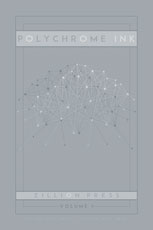 Polychrome Ink is a new biannual print and e-published journal with the mission to highlight that diversity is not a niche market, but a mass market.
Polychrome Ink is a new biannual print and e-published journal with the mission to highlight that diversity is not a niche market, but a mass market.
“Polychrome Ink is run by a group of diverse friends,” Executive Editor Em Salgado explained to me. “We met due to a mutual love of literature. During frequent literary discussions, we often noticed a shortage of characters that represented any of our individual diversity points, which only further highlighted what we felt was lacking. The need to see ourselves normalized in the literature being produced and the literature we love became our raison d’être. Eventually we grew tired of simply talking about it and decided to take matters into our own hands.”
At the editorial helm along with Em are Associate Editor Zire Fournier, Copy Editor Kimmia Masterson, and Assistant Associate Editor Zaira Fournier. Additionally, Polychrome Ink currently has eight specialty editors who assist with topics and themes in which they have experience. For example, if Polychrome Ink receives a submission with any of the following themes: gay male, genderqueer, religious, neuroatypical — the editors send that submission to Aaron for review because he, himself, is a gay neuroatypical genderqueer individual who studies theology.
Unique to this publication, writers who submit may choose the editor that they feel best suits their work. Em explained, “The process of selecting an editor with the appropriate diversity points and literary interests helps to assure writers that their submission is being reviewed by someone that their work will resonate with the most — thus making the relationship between writer and editor more personal.”
Even the name Polychrome Ink speaks to the diversity of the publication: “We were looking for a moniker that represented diversity,” Em said, “and by extension, diversity in writing. Polychrome means multicolored, yet does not have the same connotation as rainbow, since our demographic extends beyond LGBTQIA+ themes. And Ink, of course, represents the writing itself.”
Readers of Polychrome Ink can expect to find a collection of short fiction, creative nonfiction, flash fiction, essays, and poetry written by diverse authors and/or with diverse themes. Em explains that “Polychrome Ink seeks to share authentic voices and quality literature, covering an array of genres and topics, with the hopes that the work resonates with readers.”
For their inaugural issue, the featured author was Tessa Gratton, alongside Emma Mauze, Frances Kimpel, D. Michael Warren, Shana Bulhan Haydock, David Perlmutter, Yuan Changming, Anders Scott, Jan Steckel, Robin Wyatt Dunn, Courtney Hamel, Kim Luna, Jaycee Boydgarcia, Alex Franco, Malcolm Friend, and Stephen Mead.
“In terms of the future,” Em told me, “we will continue providing an outlet and resource for writers and readers alike. We would like to be amidst the publications everyone looks to for original diverse literature. We also have plans to expand our staff — thus broadening the diverse spectrum of our editorial team.”
Polychrome Ink accepts submissions via email and is approaching the end of the submission period for Volume II — which releases in October. (Submissions close July 31.) There is no reading fee and the publication is a paying market with hopes that as readership grows, so will the compensation to writers.
New Lit on the Block :: Tishman Review
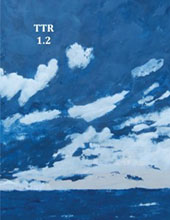 The Tishman Review gets its name from Tishman Hall, located on the campus of Bennington College where co-founding editors Maura Snell and Jennifer Porter gave their graduate lectures and readings as students in the Bennington Writing Seminars. They are joined by Joanne Nelson, editor for creative nonfiction.
The Tishman Review gets its name from Tishman Hall, located on the campus of Bennington College where co-founding editors Maura Snell and Jennifer Porter gave their graduate lectures and readings as students in the Bennington Writing Seminars. They are joined by Joanne Nelson, editor for creative nonfiction.
Publishing quarterly fiction, poetry, creative nonfiction, and art, including cartoons, the current issue of The Tishman Review is available for free online. All issues are available to purchase as an e-book and in print-on-demand.
Porter tells me they started a magazine “to be DIFFERENT. We wanted to pay our contributors, we wanted to be hands-on editors—not only reading everything that comes in (and often providing feedback) but also editing accepted pieces, we wanted to be open to what authors are creating rather than having pre-determined ideas of what they should be writing.”
As a result of their up-to-elbows approach, readers can expect to find a selection of poetry, prose and art that “speaks to the human condition” and “hopefully elicits a response, whether it be emotional or intellectual.”
There have been no preset themes for submissions, though themes have appeared from among the works once they have been selected for publication. The editors shared, “We do like to publish work that challenges the ‘isms of sex, race, age, etc.”
Among those writers whose works have been selected, in poetry: Lauren Davis, Ace Boggess, Barrett Warner, Karla Van Vliet and Jennifer Martelli; in fiction: Tamas Dobozy, Amanda Pauley, Laura Jean Schneider, Lee L. Krecklow, James English, and Mercedes Lawry; in creative nonfiction: Robert Vivian, Jayne Guertin, and Kerrin O’Sullivan.
For the July issue, The Tishman Review will begin mini-contests in which readers (on our website) and the staff vote for their favorite piece in each genre and contributors will win prize monies. The editors hope to continue working on the publication’s financial standing so as to increase contributor payments.
All poetry, fiction, and creative nonfiction submissions can be made through Submittable. There is a fee to submit works, which the editors felt a need to comment on: “There is a lot of controversy surrounding submission fees. On our website we’ve posted a Code of Ethics for our journal as we do charge a submission fee. We want each submitter to see what they are paying for. We also host regular no fee submission days that we announce through social media. We do not charge a submission fee for art or craft blog posts.”
The Tishman Review also accepts submissions of book reviews and craft essays for the Craft Talk Blog (there is no pay for these contributors, but the byline is worth it – the blog already has some excellent content that has been featured on NewPages), as well as cover art, interior black and white art, and cartoons.
Writing Maps
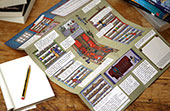 From the mastermind of Shaun Levin come a couple of fantastic creations. The first is Writing Maps. Simply designed and beautifully executed, these illustrated maps are printed on sturdy 11×16 paper and folded into eight, making the closed map about postcard size. Each map contains writing prompts related to the subject of the map. For example: Write Around the House: Writing Prompts to Explore the Rooms We Inhabit; Writing Art: Writing in Galleries and Museums; The Café Writing Map: Writing Prompts for Cafes, Bars, Bistros, and Pubs; Writing Things: Writing About Objects and the Things We Carry; How to Write a Story Writing Map; Write Around the Bookshop.
From the mastermind of Shaun Levin come a couple of fantastic creations. The first is Writing Maps. Simply designed and beautifully executed, these illustrated maps are printed on sturdy 11×16 paper and folded into eight, making the closed map about postcard size. Each map contains writing prompts related to the subject of the map. For example: Write Around the House: Writing Prompts to Explore the Rooms We Inhabit; Writing Art: Writing in Galleries and Museums; The Café Writing Map: Writing Prompts for Cafes, Bars, Bistros, and Pubs; Writing Things: Writing About Objects and the Things We Carry; How to Write a Story Writing Map; Write Around the Bookshop.
Shaun explains: “Writing Maps are created to suit writers of all genres and levels. Writing Maps are devised to inspire stories, spice up your writing routine, expand your work, develop work-in progress, and make sure you have writerly fun in ways that’ll surprise you.” There are currently 16 maps available with more planned, such as Writing School Map and Write Around the Garden.
In addition to the Writing Maps, Shaun is editor of The A3 Review, a publication folded in the same style as the maps, featuring poetry and prose with a 150 word limit. With room for a cover and back cover, 14 writer’s works can be featured in each publication. The contributors come from a monthly writing contest in response to changing prompts. Current and upcoming prompts: Green Things; Journeys; Hands. Contest winners receive a cash prize, with two works selected each month for publication in The A3 Review.
New Lit on the Block :: Julep Journal
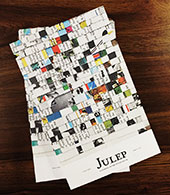 Based out of Nashville, Tennessee, Julep Journal has just issued its third print volume to complete its first year of publication. Named, as you might well have guessed, after the delightful southern cocktail, the editors comment, “We identify with it. It’s Southern by origin and in spirit. It’s refreshing, clean. It’s simple but has innumerable variations.”
Based out of Nashville, Tennessee, Julep Journal has just issued its third print volume to complete its first year of publication. Named, as you might well have guessed, after the delightful southern cocktail, the editors comment, “We identify with it. It’s Southern by origin and in spirit. It’s refreshing, clean. It’s simple but has innumerable variations.”
In keeping with that refreshing spirit of variation, Julep publishes all genres – fiction, poetry, creative essays, academic treatises – and, according to the editors, “we especially love pieces that exist between or beyond those boundaries. In other words, if it doesn’t fit in with more rigid, binary journals, there is a home in Julep.”
Giving this new writing a home are founding editors Joseph Storey, Kevin Foster and Greg Frank, and editors Brittney McKenna and Theron Spiegl, who “like good Southerners, believe in the power and beauty of a fine physical object.”
When asked the motivation for starting up a literary magazine, the editors go back: “Years ago, we would sit around coffee shops and complain about the state of cultural journals. So many do little more than spin the wheels of their chosen genre, advance a binary political position with an inherently limited type of nuance, or represent only a corner of a region. We dreamt of a journal that advances art, represents the spectrum of the creative work of a region, and pushes beyond political binaries. The narrative of the Southern Renaissance, Nashville and the surplus of its creative economy, was rolling at the time. So we decided to start a journal as a platform for the work that was happening.”
As such, readers of Julep can expect to find anything and everything that fundamentally excellent writing and visual art. “A distinctly Southern, non-binary artistic and cultural perspective,” the editors promise readers. “The best work of upcoming Southern intellectuals and artists.” The most recent issue features works by Eileen Fickes, Stephen Mage, Daniel Pujol, Cameron Smith, Matthew Truslow, Jessica Kennedy, and featured artist Robert Scobey.
While publishing as a triannual the first year, the editors are planning to extend the length and cultural commitment of each journal and move to biannual printing. “We want every issue to eclipse the last in cohesiveness of theme, quality of work, and physical beauty. In order to accomplish this, we’re planning to publish twice yearly rather than thrice, with a greater range of art. We also want to build and grow our partnerships with artistic and cultural institutions across the South, including cohosting events of all types. Why create if it’s not ambitious?”
For writers, the editors are always accepting new pieces. The next issue will be available in mid-June, with plans to select pieces for Issue Five by the end of July. Visit the Julep website for more specific information about genres.
The most unique quality of Julep’s model is editorial. We reject the notion that ideas – and the attempts of writers and artists to express those ideas – exist in a vacuum. Julep’s team of editors support writers as they hone – and even sometimes create – their pieces. It’s a messier process, but the pieces turn out better and the final product is more thematically cohesive.
New Lit on the Block :: The Maine Review
Editor Katherine Mayfield and Intern Bonnie Irwin bring readers and writers The Maine Review, a new print/e/Kindle quarterly publishing short fiction, CNF, poetry, essays on writing, and black-and-white interior art. They also publish annual collections of short fiction (summer) and poetry (winter).
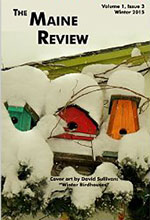 While the name, The Maine Review, seems obviously to represent the location of the publication, Mayfield tells me it was inspired “in the tradition of reviews like The Missouri Review and The Iowa Review. We felt that Maine needed a literary review representing the beauty and ruggedness of the Pine Tree State. Though we publish well-known and new and emerging authors from around the world, we feature the work of Maine artists on each issue’s cover. The Maine Review is a proud member of the Maine Writers & Publishers Alliance, a nonprofit membership organization that works to enrich the literary life and culture of Maine.”
While the name, The Maine Review, seems obviously to represent the location of the publication, Mayfield tells me it was inspired “in the tradition of reviews like The Missouri Review and The Iowa Review. We felt that Maine needed a literary review representing the beauty and ruggedness of the Pine Tree State. Though we publish well-known and new and emerging authors from around the world, we feature the work of Maine artists on each issue’s cover. The Maine Review is a proud member of the Maine Writers & Publishers Alliance, a nonprofit membership organization that works to enrich the literary life and culture of Maine.”
With such great role models already influencing this new publication, I asked Mayfield what motivated her to start her own journal, “Throughout my many years of writing and editing, I’ve seen so much excellent writing that never finds a home, and I wanted to give more writers the opportunity to be published. I also thoroughly enjoy putting the issues together – it’s like working a jigsaw puzzle, moving pieces around to get a good ‘flow.’ The Maine Review also provides a wonderful opportunity to showcase Maine artists.”
Mayfield also commented on what readers could expect to find in the publication: “Our mission is to publish quality writing that touches readers and engages their hearts, minds, and imaginations, expanding their view of the world and of life as a human being.” While the publication remains fairly “traditional” – not publishing genre horror or fantasy – Mayfield says they do look to feature humor in every issue.
Some recently featured authors include Author’s Guild President Roxanne Robinson, Maine Senior Poet Laureate Roger Finch, award-winning poets Annie Finch, Jason Michael MacLeod, Claire Scott, David Sloan, and Sean Sutherland.
In addition to the annual collections of short fiction and poetry, in the next year Mayfield says she’d like to publish an annual collection of CNF/memoir. Just now nearing the end their first year, The Maine Review looks forward to expanding the size and scope of the publication over the next few years.
The Maine Review holds contests and open reading periods. The next contest, for the Fall 2015 issue, will open in late May with a June 30th deadline. The contest for the annual poetry collection will open in autumn. The publication also has two open reading periods (no fee) each year for the Winter and Summer issues with submissions for those issues only accepted during the reading periods. See the publication’s website for more specific information. Submission is via the website and there is also a form available on the website for mailing submissions via USPS.
New Lit on the Block :: Bear Review
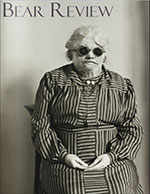 Based out of Kansas City and Seattle, Bear Review is a new independent online biannual of poetry and micro-prose (under 500 words) as well as visual art. Between issues, Editors Marcus Myers and Brian Clifton also post Bear Review authors reading their work on Soundcloud and Tumblr.
Based out of Kansas City and Seattle, Bear Review is a new independent online biannual of poetry and micro-prose (under 500 words) as well as visual art. Between issues, Editors Marcus Myers and Brian Clifton also post Bear Review authors reading their work on Soundcloud and Tumblr.
In starting a literary magazine, Myers and Clifton say they like the juxtaposition inherent in those publications. “When reading one, you never know what will be on the next page–your new favorite poem? your best friend from childhood? a plot that destroys everything you though about storytelling? The possibilities are endless. We wanted to create a space in which this excitement could live and grow. Part of the fun for us is putting each issue in order and seeing how the text and images converse with one another. In a phrase, our mission is to keep our readers guessing.”
And while the name Bear Review might seem to invite eco- or nature-themed writing, the inspiration expresses a more complex metaphor. When Myers was a teenager, he went hiking and came across a bear face-to-face. The experience was full of beauty that turned into danger and fear. Myers writes, “As readers, we crave that specific sort of encounter from each poem or flash piece we happen upon. Our favorite pieces, like literary bears, have a mix of beauty and danger that leaves us with a greater respect for what’s real. And we want to share this vital wonder with our readers. “
Reader of Bear Review can expect to find this mix of beauty and danger throughout, though since the editors are both poets, the publication is bias to that genre. (“But we do love micro-prose,” says Myers.) In both prose and poetry, Myers assure me that readers can expect to find a wide breadth of styles and contemporary modes as well as visual art from critically acclaimed photographers, illustrators, and painters.
Some recent contributors include Moikom Zeqo, Mathias Svalina, Jordan Stempleman, Lisa Russ Spaar, DA Powell, Rusty Morrison, Wayne Miller, Emily Koehn, Megan Kaminiski, Miriam Gamble, John Gallaher, Drew Cook, and Hadara Bar-Nadav.
Myers tells me that future plans for Bear Review are to continue making the journal “a beautiful place for the poems and prose we love; we want to continue to bring an audience there. We want to provide a place where established and soon-to-be established writers can share the same stage.” A chapbook contest, website expansion for close readings, and book reviews and interviews are all in the works.
Bear Review takes submissions year round via submittable, and Myers and Clifton say they read each submission out loud. All work done as a labor of love, Bear Review is a welcome addition to the literary arts community.
[Cover: “Victim of Explosion” by August Sander, 1930]
New Lit on the Block :: The Birds We Pile Loosely
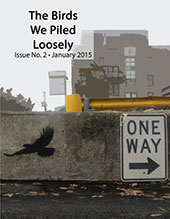 The Birds We Piled Loosely (or BPL for short) is an online quarterly interested in publishing “anything we can fit into our magazine,” according to Editors Johnathan McClintick and Nicole Letson. For that reason, readers coming to BPL can expect to find just about any kind of writing: from villanelles, to essays, etc. And art can range from photography, painting, illustrations, graphic design etc. BPL is published as a pdf (free to download) because the editors found using InDesign allows them to more easily format non-conventional pieces. Also, McClintick notes, “we can curate the magazine so that the pieces inside read together in a complementary order, and the magazine can readily be shared and circulated.”
The Birds We Piled Loosely (or BPL for short) is an online quarterly interested in publishing “anything we can fit into our magazine,” according to Editors Johnathan McClintick and Nicole Letson. For that reason, readers coming to BPL can expect to find just about any kind of writing: from villanelles, to essays, etc. And art can range from photography, painting, illustrations, graphic design etc. BPL is published as a pdf (free to download) because the editors found using InDesign allows them to more easily format non-conventional pieces. Also, McClintick notes, “we can curate the magazine so that the pieces inside read together in a complementary order, and the magazine can readily be shared and circulated.”
McClintick says BPL “started on a whim, but as we’ve gotten more engaged with the work, we really see it as a chance to help writers and artists get more visibility online.” Like many start-up publications, there’s no paycheck for those involved, but nor does the publication ask for payment. “All our work is voluntary and we see it as community service,” comment McClintick, “We love having the chance to share the work of others and give readers the chance to find more work like it. This is why our contributor’s bios contain links to other work they’ve done or are doing. We want readers to read more and discover more; our magazine is just a starting point for them.”
Some featured contributors to the first two issues include Emma DeMilta, Glen Armstrong, Karen J. Weyant, Luke Thurogood, Rob Cook, Robin Wyatt Dunn, Patty Somlo, John Colasacco, who has a book coming out this May through CCM Press, and Howie Good, whose Fugitive Pieces proceeds will be donated to charity.
And the name – why The Birds We Piled Loosely? The answer reveals a whimsical side: “We liked birds! And besides, the great danes piled loosely would just sound silly,” McClintick jokes. “In reality,” he says, “we came up with a shortlist of several different names and passed them around to friends and settled on the name people liked the most.” The result is indeed intriguing and unique.
In the future for BPL, the editors want to look for ways to incorporate video and audio, consider print options and different website designs, and feature a sample of an author’s newly released book. Already, issue three will feature poems from Rob Cook’s new book Asking My Liver for Forgiveness.
For submissions, the editors tell writers to submit “text pieces” instead of any one genre because they don’t want to discourage people from submitting in any medium or style of writing. As for art, they’re really open to anything there as well. Letson’s background and career is in visual design, while McClintick’s is in writing and editing, so they complement each other in the type of work they’re looking for.
McClintick stresses to writers: “Understand that we won’t know your name or publication history when we review the piece. We’ve rejected writers claiming they had over a 100 publications and accepted writers who have never been published. We’ll take a look at any type of writing and judge it on its merit alone. Name dropping publications when you submit your piece doesn’t impress us.”
McClintick and Letson offer this final word: “We really believe in the work we’re doing and in our contributors! We want to thank them again. This magazine is really for our contributors and readers, and we can only hope that when someone opens the magazine that they can see all of this in our work.”
New Lit on the Block :: Brain of Forgetting
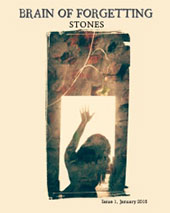 Brain of Forgetting is a new bi-annual (winter/summer) PDF and print (CreateSpace) publication of poetry, flash fiction, creative non-fiction, photography, artwork published by Brain of Forgetting Press with Editor-in-Chief Bernadette McCarthy and Associate Editor of Visual Art Tom Jordan.
Brain of Forgetting is a new bi-annual (winter/summer) PDF and print (CreateSpace) publication of poetry, flash fiction, creative non-fiction, photography, artwork published by Brain of Forgetting Press with Editor-in-Chief Bernadette McCarthy and Associate Editor of Visual Art Tom Jordan.
The name Brain of Forgetting, McCarthy tells NewPages, “is drawn from the Irish legend of Cenn Fáelad, who lost his ‘brain of forgetting’ when his skull was split open by a sword-blow in battle. Cenn Fáelad developed a photographic memory for historical and legal information, which he wrote out in verse and prose on tablets. The journal honours his legacy by providing a forum for work that engages with archaeology, history, and memory, while recognising that pure, neutral historical fact does not exist in itself: the human (mis)understanding of history is not only susceptible to forgetting, but a natural tendency to impose a narrative structure on the past and invest it with meanings determined by the present.”
Based in Cork, Ireland, the journal brings together the intellects of archaeological researcher and poet Bernadette McCarthy and photographer and art historian Tom Jordan. Unable to discover a literary journal that bridged the gap between academic research and creative output, McCarthy set up the journal in September 2014, advertising a call for submissions on the theme of “Stones.” She attended an exhibition of her friend Tom Jordan’s photography, which focused in particular on recording built heritage, and asked him to come on board as editor of visual art. This issue is now available here to purchase as well as for free download from the site.
In starting a new publication, McCarthy tells NewPages, “We hope to raise more awareness of the importance of protecting our past heritage, and how the past is not dead, but can help us reach a deeper level in our own creative work, and understand our present reality in a more complex way. The past isn’t black-and-white, and there is no one narrative of what history entails; this is a central message of Brain of Forgetting. The process of ‘digging’ into the past and uncovering new meaning is vital to individual and collective social identity, and Brain of Forgetting hopes to address this need by negotiating the boundaries between past and present, creative imagination and historic record, and lyricism and bare-boned data.”
Readers of Brain of Forgetting will find creative work that relates to the past, but, as McCarthy says, “this work must have a contemporary edge.” A variety of writers and artists from all over the world were published in Issue One, many of whom had quite diverse backgrounds. Some were professional archaeologists, anthropologists, medievalists, and geologists; others were professional writers and artists who find the past to be a fruitful source of inspiration. “All work published was chosen not simply because it related to the past,” McCarthy stresses, “but on the basis of its quality and originality—subjective indeed, but we try our best!”
The editors are excited about the upcoming Issue Two, which will feature new poetry by Afric MacGlinchey, as well as new translations by Rosalin Blue of the poetry of August Stramm, who died in World War I.
Looking to the future, in an ideal issue of Brain of Forgetting, Bernadette McCarthy would love to include work from one of her favorite archaeologist-poets, Paddy Bushe, and perhaps creative non-fiction by the likes of Christine Finn, author of Past Poetic: Archaeology in the Poetry of W.B. Yeats and Seamus Heaney. In general, however, she is interested in original work from anyone that engages with the past, regardless of whether s/he is an established or emerging writer.
Tom Jordan would love to publish a previously undiscovered essay by Hubert Butler, author of Ten Thousand Saints, who bridged the gap between history and imagination in his writings. He is also a fan of Irish artist Robert Gibbings and cosmologist/author Carl Sagan, but in general he welcomes anything well-done that relates to the chosen theme of the journal.
For now, McCarthy says, “Surviving is our main goal at present, and perhaps gathering enough funding together to be able to pay a local company to do the printing for us – though we are grateful for the existence of online independent publishing platforms. We would also like to try and reach a wider readership, and publish an even more diverse range of writers. So far, most of the work submitted has emanated from Ireland, the UK, Canada and the US. It would be great to feature more work from the wider Anglophone world e.g. parts of Africa, Asia, and Australasia where English is spoken.”
Submissions for Issue Two, based around the theme of “Poppies,” are open until the end of March. Up to four poems or two pieces of flash fiction (900 words max.) can be submitted, while submissions of creative non-fiction (one piece, 1200 words max), as well as photography and other artwork are also welcome. While the journal is primarily English-language, work in other languages can be considered if accompanied by English translation suitable for publication, while translations of pre-1500 English-language work are gladly considered. Simultaneous submissions are accepted, as long as the contributor informs the journal if a piece is published elsewhere. All work submitted must be previously unpublished in print or online. See Brain of Forgetting‘s website for more information.
New Lit on the Block :: Tahoma Literary Review
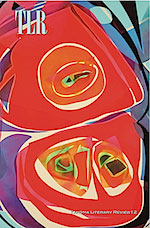 Now in its second issue, Tahoma Literary Review is a publication of poetry, fiction and nonfiction based in the Puget Sound region of Washington State. Published three times per year, TLR is available in print, PDF, epub and Kindle formats. In addition to these print and electronic editions, TLR offers featured readings by contributors via Soundcloud.
Now in its second issue, Tahoma Literary Review is a publication of poetry, fiction and nonfiction based in the Puget Sound region of Washington State. Published three times per year, TLR is available in print, PDF, epub and Kindle formats. In addition to these print and electronic editions, TLR offers featured readings by contributors via Soundcloud.
Continue reading “New Lit on the Block :: Tahoma Literary Review”
New Lit on the Block :: Bridge Eight
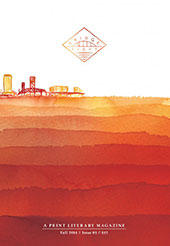 Based out of Jacksonville, Florida, the biannual print Bridge Eight Literary Magazine publishes literary fiction, poetry and creative non-fiction.
Based out of Jacksonville, Florida, the biannual print Bridge Eight Literary Magazine publishes literary fiction, poetry and creative non-fiction.
The magazine is published by Bridge Eight, a small independent press that seeks to build the literary culture of Northeast Florida, while publishing work from writers all over the world.
Publisher Jared Rypkema is based in Jacksonville, a city known for its seven bridges. He says, “Bridge Eight provides an ‘eighth bridge’ that will take readers to new imaginative destinations, connecting new voices and new readers, and venturing far beyond the boundaries of the city we call home.” Since its inception, Rypkema notes, Bridge Eight Literary Magazine has been wonderfully received both locally and regionally, earning the support of Jacksonville’s cultural council and arts community. Others working to make the publication happen include Managing Editor Coe Douglas, Senior Fiction Editor Melanie Webb, and Senior Poetry Editor Teri Youmans Grimm.
Bridge Eight started as a community-building organization that sought to connect Jacksonville-based writers and create a movement of literary culture within the city. After a year of hosting workshops and community events, the literary magazine concept was born in order to publish outside influences alongside those grown in Jacksonville, FL. Since there were no other independent literary magazines in Jacksonville, Bridge Eight became the only one of its kind when it published its first issue in November 2014.
Rypkema tells me, “As artists and writers first, publishers second, we carry a commitment to bring our readers the best writing we can, presented in the best way possible. We work with amazing artists for our design and the best printers in the country. For readers, this is a magazine that will not only be a great read, but feel and look amazing as well.”
Recent contributors include Mark Ari, editor of EAT Poems, Editorial Advisor to Fiction Fix, and author of The Shoemaker’s Tale; Teri Youmans Grimm, author of Dirt Eaters and Becoming Lyla Dore (forthcoming); and Lee Matalone, whose writing has recently appeared in the Noctua Review, Verbaleyze’s Young Writers Anthology, the Eunoia Review and the Stoneslide Corrective.
Bridge Eight continues to host workshops for Jacksonville-based writers and presents the semi-regular reading series, Abridged. Rypkema looks to the future of the publication: “As almost all other independent literary magazines, sustainability was key to our foundation. The decisions we’ve made and people we’ve worked with over the past year have set the magazine up for success in the years to come – where we hope to become a go-to for literary publishing in Northeast Florida. Bridge Eight Literary Magazine will always be on the lookout for excellent work that speaks to the very elements of humanity.”
Bridge Eight Literary Magazine accepts submissions on a rolling basis. Submissions received on or before February 15, 2015 will be considered for Issue 2 (Spring 2015).
When in Drought Zine
A new zine called When in Drought is hitting the streets in a small print run from Los Angeles. With a tongue-in-cheek and often political attitude, it has no problem standing out from a crowd of other literary magazines. Each issue is themed and contains writing, art, and translation “with neglected literature from around the world.” To get a feel for them, here’s some excerpts from their submission guidelines: “Whatever it is, we’re against it. Just kidding. We love you.” And at the bottom of each page on their site, they declare, “Stay horny for art.” And on their contest page, they have some sample titles of books that if written, they would pay good money for: Nude on a Chair; Look Mom, the Children Don’t Have Any Pants Today; Mein Kampf, Your Kampf, Let’s Call the Whole Thing Off; Tits Laid Heavy on My Thoughts: A Memoir; and other humorous suggestions.
The latest issue is themed Prague: “never in recorded history has the municipality of Prague experience drought. On the contrary, it has withstood floods, torrential downpours, &, quite often, thunderstorms . . . It is no wonder then that the editors of this journal should be fascinated with such a place . . . We hope you will soon find your thirst slaked—& please, when in Prague, do not forget your umbrella.” The issue itself contains 100 pages of original work combined with passages from Franz Kafka.
New Lit on the Block :: Isthmus
Isthmus, edited by Ann Przyzycki, Randy DeVita, and Taira Anderson, is a new biannual print magazine that publishes fiction, nonfiction, and poetry. Hailing from Seattle, Washington, Isthmus offers “good writing that will make you want to pass the issue to a friend.” Przyzycki says, “We value the traditional as well as those pieces that organically can only be told through experimentation with form.”
Przyzycki recalls a time when all three editors were stuck together in traffic on the interstate highway running north to south through Seattle. One editor remarks that the reason for the bottleneck traffic in Seattle is that the city is built on an isthmus. Later, when coming up with a name for the journal, Przyzycki says they looked back on this moment and chose Isthmus to refer not only to the city it was based out of but also to the geographical term and the accompanying metaphor: “a narrow connection between two larger objects, as the printed journal is a connection between the writer and the reader,” she says.
But as with all new journals, we ask why? Why start a literary magazine? And in Przyzycki’s research, she found that most start because the editors don’t feel like there is “a venue for a certain kind of story, that there is some hole to fill”—and she would be right. She is fully aware of the vast amount of venues already out there but says “I don’t think that there can be too many opportunities for good writing to be shared.” Inspired by the independent presses and magazines at AWP this year, she believes that many writers are looking to independent lit mags for “new voices.” She loves the honor of allowing someone else to trust her with their work; “I love working on books and so perhaps naively I feel that my passion for publishing and connecting writers to readers is reason enough.”
As the journal grows, Przyzycki hopes to include translations on a regular basis, increase the online presence, and include more book recommendations and author interviews on the website.
The first issue features fiction by Jennifer Bryan, Michal Davis, and Leslie Parry; nonfiction by Kelly Chastain, Elizabeth Mack, and Mark Rozema; poetry by Louis Armand, Cody Deitz, Suanne Fetherolf, Natalie Giarratano, Matt Hemmerich, Gabe Herron, Patrick Kindig, Jed Myers, Jason Olsen, Natania Rosenfeld, Mike Smith, Haley Van Heukelom, Laurelyn Whitt, and Theodore Worozbyt.
Isthmus editors read year round for poetry, fiction, and nonfiction. You can submit through Submittable only; please find complete guidelines on their website. They also note that you should check in regularly with their blog and Facebook page for announcements of any upcoming special issues or future contests.
New Lit on the Block :: The Austin Review
The Austin Review, a neatly-bound, fit-in-the-palm-of-your-hand journal, is now being produced in Austin, Texas, three times a year. Editor-in-Chief Michael Barrett says that Austin “is home to an incredibly talented group of writers and publishers, and we thought the city deserved a journal bearing its name.” Publishing four short stories, four pieces of flash nonfiction, and on essay or work by a notable author in each issue, The Austin Review is also available as a Kindle version.
But with so many literary magazines already out there, the question is always, why start another? Well, along with the common mission to discover new work from emerging authors, Barrett, to some extent, wants to “highlight the talented authors coming from Austin and help expand the literary community in the city.”
As the magazines grows, Barrett—along with Managing Editor Tatiana Ryckman and Associate Editor Wendy Walker—plans to keep to the nine works per issue but to eventually share a limited number of additional works on their website. “We also intend to expand our nonprofit and outreach efforts and help promote the love of literature in our community,” he states.
The first issue features short stories by John Jodzio, T Kira Madden, Derrick Brown, and Boomer Pinches; flash nonfiction by David Olimpio, Lisa Wells, Caitlyn Paley, and Patrick Madden; and an essay by Sheila Heti. “Readers can expect to find contemporary works of the highest quality, curated with great care and attention to detail,” says Barrett.
The magazine accepts submissions year-round through Submittable, and you can purchase a print copy from their website or a digital version from Amazon.
New Student-Run Literary Arts Magazine: Howl
Deltona High School’s new online literary arts magazine, Howl, is an after-school organization staffed by students and advised by English teacher Dylan Emerick-Brown. The goal of Howl is two-fold: 1) to teach high school students how to write creatively and clearly in their own voices; analyze, evaluate, and edit others’ work; learn about the writing/editing field as a career option; and overall, expand their minds to the world outside of Deltona and 2) to provide the world with quality selections of literature from which to read and learn.
Deltona High School students read, edit, and publish poetry, fiction, non-fiction, and art from submissions gained either from other Deltona High students or from international submissions that come in from across the globe, giving these students real-time, real-world insight into the world in which they live. They also have partnered with Other Press, Chicago Review Press, and other publishers to read advanced copies of books and write real book reviews. Designers in the class have created website content, web banners, t-shirt designs, and more all while learning about the process of graphic designing as part of a staff from beginning to end. Additionally, the students get to interview acclaimed writers and publishers from around the world either via Skype (face-to-face, so to speak) or email. So far, our students have interviewed or are currently slated to interview:
Robert Pinsky – former US Poet Laureate
Diane McWhorter – Pulitzer Prize winner in fiction
Elizabeth Strout – Pulitzer Prize winner in fiction
Paul Harding – Pulitzer Prize winner in fiction
Lois Lowry – author of The Giver
Lauren Kate – author of The Fallen series
David Levithan – author of Nick and Norah’s Infinite Playlist
John Maguire – author of Wicked
John Duff – Vice President and Editor for Perigee Books, a division of Penguin Books
Barbara Epler – Editor-in-Chief of New Directions
Yuval Taylor – Editor for the Chicago Review Press
The staff of Howl does everything that a professional literary magazine does, and then some. The experience they gain is valuable for continued success in the classroom as well as for future endeavors in the literary arts. Their passion and drive is what runs the website and new, innovative ideas are always spawning from our weekly meetings. The students look forward to setting new goals, expanding their minds, and contributing to the global literary conversation.
New Lit on the Block :: Parallel Ink
Parallel Ink is a new publication with the mission to “publish insightful writing, by students for students around the world.” It is a place where young writers, aged 12 to 18, can receive feedback on their work, get the opportunity to meet other talented artists and authors, and experience the publishing world. Printed online twice a year, Parallel Ink features poetry, narratives, essays, experimental writing, fanfiction (if in good taste), paintings, drawings, digital art, “and anything else you can take a picture of and put online.”
“We’re both math and language geeks,” writes Managing Editor Jamie Uy. “Parallel Ink abbreviated happens to be PI (Pi, or π)! [It] has a nice ring to it, and the name plays on the idea that different stories, like parallel lines, can co-exist and grow in similar ways. Writing is universal.”
Editors Jiyoon Jeong (Senior Editor, Art & Korean Translation) and Puinoon Na Nakorn (Senior Editor, Technology & Thai Translation) join Uy to publish issues that Uy describes as being “roughly 20 pages of columns about issues teens face today, thought-provoking and humorous essays, historical/realistic/fantasy poems (some rhyming, some free verse), Korean & Thai translations, and stories about the past/future/present, with illustrations here and there.”
The first issue features poetry by B.L.P (pseudonym), Gene Vichitanan, LuLu Labbe, Chloe Duval, and Elaine Park; narratives by Vincent Tantra, Helen Chang, and Elaine Park; and essays by Swish Dish (pseudonym), Emma Breber, Elle Schenk, and Darin Sumetanon.
Submissions are accepted year-round through an online form. They will continue to consider pieces fro the July 2014 issue until June 10. All artwork can be sent to [email protected]
Uy also wishes to mention that they welcome guest editors, columnists, translators, and artists. If interested, contact them at the above email address. Uy says, “All of our senior editors live in different countries and we love working with people around the world.”
New Lit on the Block :: Middle Gray Magazine
Middle gray, in visual art, is the color tone halfway between black and white. “In other words, it’s a perfectly neutral gray,” says the managing editor of the new quarterly online magazine titled Middle Gray Magazine. “We thought the concept of ‘neutral gray’ was very appropriate for a place the showcases art, since this color is meant to neither enhance nor diminish the hues of the artwork being displayed. It allows it to show its true colors,” Alvaro Morales says. The magazine is an eclectic mix of fiction, nonfiction, poetry, photography, paintings, illustrations, mixed media, bands, ensembles, composers, drama, screenplays, animation, and so much more. “We consider all types of creative work and encourage artists with non-traditional work to submit,” Morales says. And although the magazine itself only features written and visual work, the accompanying blog publishes interviews, music, and video features.
Working alongside Morales are Catalina Piedrahita (Editor-in-Chief/Visual Arts Editor) and Dariel Suarez (Letters Editor). They started the magazine as a space for emerging artists to display their work. Morales explains, “We intend to build a creative community that encourages artistic connections, collaborations and cross-pollination.” In the future, they would like to organize events in the Boston area where the featured artists can present their work through readings, galleries, performances, and the like.
Their first issue features fiction by Jonathan Escoffery; nonfiction by Sandra Jean-Pierre; poetry by Natasha Hakimi, Joe Lapin, and Fausto Barrionuevo; screenplay by Erick Castrillon; visual arts by Eileen Clynes, Michael Gray, Sophie Bonet, and Laura Knapp; and music by Unlimited Perception and Videri String Quartet.
Middle Gray accepts ongoing submissions without any special themes. Submissions are sent in via email; read more here.
New Lit on the Block :: Driftless Review
The name Driftless Review (of a new lit mag) refers to the area in SW Wisconsin, NE Iowa, SE Minnesota, and NW Illinois where the geography was left unharmed after the last ice age, 10,000 years ago. “Think deep river valleys,” says Contest Co-Editor and Assistant Prose Editor Bill Yazbec, “plush forests, and cold water streams carved in limestone bedrock.”
But this new magazine, too, has some history. As Yazbec says, “it’s a resurrection of a previous incarnation spearheaded by Russ Brickey.” Published by Platteville Poets, Writers and Editors, LLC, Driftless Review comes out twice a year, in May and December, and features fiction, poetry, flash fiction, nonfiction, interviews, visual artwork, and book reviews. “While we strive to be a respected national literary publication,” Yazbec says, “we always place a focus on emerging writers in the Driftless area.”
But Yazbec is not alone in this endeavor. Fellow editors include Kara Candito, Teresa Burns, Colin Lessig, Russ Brickey, and Laura Beadling. They aim to grow their readership and “become a ‘staunch character’ in the rich tradition of Midwestern literary magazines and journals.”
The publication is geared toward readers that might read the NYT, Rain Taxi, and The Believer, “but also still get the local newspaper delivered in the mornings.” Yazbec says that Driftless Review is for “a reader that is fascinated by what’s out in the world, but content to appreciate the beauty of the Midwest and the kindness of the people here.”
He says the writing they aim to publish has “well-wrought characters in situations that shed some new light on the human condition. Tight, clean, unassuming prose that mirrors our Midwestern sensibility.” He goes on to say that they don’t care “about the poet’s aesthetic allegiances as much as [they] care about the work’s human urgency.”
The first issue features prose by Bonnie Jo Campbell, Lydia Conklin, Sam Snoek-Brown, Matthew Fiander, Paul Crenshaw, Jen Kerske, and Jacob Reecher; poetry by Fleda Brown, Rita Mae Reese, Matthew Guenette, Sam Amadon, Liz Countryman, Kyle McCord, Rodney Wittwer, Justin Bigos, Matthew Mutiva, and Kaela Mellen; and visual art from Lydia Conklin.
Electronic submissions are accepted year-round, and submission guidelines can be found on their website.
New Lit on the Block :: The Atlas Review
The Atlas Review, a new biannual print journal, has a mission “to extend aesthetic qualities/dilemmas beyond a few communities and into the open air of all voices.” Editor Natalie Eilbert says: “It is our hope that through our anonymous submission system, we can graph a new geography of writers and artists, from Idaho to the Philippines.”
Along with Eilbert, Editors Jillian Kuzma and Dolan Morgan publish poetry, fiction, nonfiction, interviews, and art in the issues. Eilbert says that you can expect to find writers that you can both recognize and admire, noting that you can find interviews with the likes of George Saunders, Amelia Gray, and C. D. Wright.
With a desire to engage as many communities as possible, Atlas Review only accepts submission anonymously. They do, however, also solicit pieces from bigger names to draw a wider audience for readership. “We like the energy this creates,” says Eilbert. “We’d like to think of the magazine as one especially for writers (as if there exists a lit mag whose audience is not writers) by writing letters to our accepted authors articulating just why we were drawn to their submission, being active editors in pieces we enjoy, writing letters of encouragement to writers we find striking but whom we are unable to take in a given reading period, and finding as many opportunities to get our writers involved in reading events, their own communities (we ask, for example, in what bookstores our writers would like to see their work featured), and even the magazine itself (we have “guest readers” for each reading period, former contributors interested in vetting submissions).”
The first issue features poetry by Eileen Myles, Caitlin Dube, Michael Simon, Christopher DeWeese, Justin Boening, Patrick Gaughan, Anna Journey, Joe Hall, Ken L. Walker, Cori A. Winrock, Marci Vogel, Safiya Sinclair, Robert Ostrom, Kathleen Ossip, Brandon Kreitler, Meg Day, Matthew Zingg, Rachel Carstens, and Russ Woods; fiction by Jacob Mercer, Catherine Lacey, Judy Caldwell-Midero, Jon Steinhagen, and Sam Allingham; art by David Michael Schmidt, Bianca Stone, Jenny Harp, Noah and Nathan Rice, Kristof Didrickson, Roxy Drew, and Brett Rees; and an interview with George Saunders.
Right now, the editors are eagerly working on issue 2 as well as some new developments they can’t quite reveal yet. “We’ve got a whole lot of plans for reading events this summer which we cannot wait to declare—like, seriously big plans ahead there and we’re gripping our seats to tell you but must hold on!” Issue 2 will feature work by Italian writer Gabriella Ambrosio (translated by Alastair McEwan), Mike Meginnis, Camille Rankine, Rachel Glaser, Mr. Fish, and interviews with C. D. Wright and Amelia Gray.
Atlas Review accepts submissions through submittable but asks that you remain completely anonymous. Do not include your name or “identity-revealing information” anywhere in your submission. However, they do not have an open submission period at the moment.

